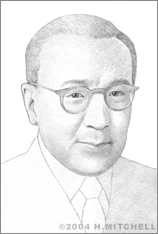Robert Wattson-Watt
Robert Watson-Watt was born April 13, 1892 in Brechin, Scotland. In 1912, he completed his BSc in engineering at University College, Dundee, which was then part of the University of St Andrews.
Watson-Watt was especially interested in radio waves during his college years. Upon graduation he worked as an assistant to professor William Peddie, who encouraged his interest in the subject, but in 1915 he began a job as a meteorologist at the Royal Aircraft Factory. There he focused on using radio waves to locate thunderstorms to be able to warn pilots. When lightning ionizes in air, it gives off a radio signal. Watson-Watt planned to detect and use this signal as the basis for his warning system. During the course of his research, however, he realized there was a need for a quick way to record and display these signals. In 1916, he first proposed using cathode ray oscilloscopes for this purpose. These devices became available in 1923. Thus, storms several hundred miles away could be located accurately.
In 1924 Watson-Watts moved to the Radio Research Station in Slough, Scotland. He was named superintendent of the National Physics Laboratory (NPL) in 1933, and, later that year, superintendent of a new radio division of the NPL in Teddington. After hearing that the aggressive Nazis had developed what they called a “death ray,” capable of destroying entire towns and cities by air, the government asked him to develop a radar (Radio Detection and Ranging) tracking system for detecting aircraft movement.
The concept of radar had been mentioned years earlier in science fiction books and many nations were working on similar technologies. Watson-Watt is credited with developing the first successful full-fledged working system. Presented in a report in 1935 entitled “The Detection of Aircraft by Radio Methods,” his research preceded a successful test using a short-wave radio transmitter against a Heyford Bomber. The test was conducted in secret, reportedly with only three witnesses. Watson-Watt was subsequently named superintendent of a new division of the Air Ministry, the Bawdsey Research Station, in 1936. By the end of 1938 a secret system was in place along the East and South coast of England, just in time for the outbreak of war in 1939.
During the war, Watson-Watt’s invention proved invaluable in helping the British forces defend themselves against German aircraft. It helped the Royal Air Force win the Battle of Britain in 1940, and was instrumental in ending “The Blitz” in 1941. Eventually it was able to detect aircraft at up to 100 kilometers. Watson-Watt was knighted in 1942.
In 1939, Watson-Watt was named Scientific Advisor on Telecommunications (SAT) to the Air Ministry. He travelled to the United States to assist in setting up radar there as well. After World War II concluded he spent much of his time in Canada and the United States, and he published a book, “Three Steps to Victory,” in 1958. He returned to Scotland in the 1960s, where he died December 5, 1973.


